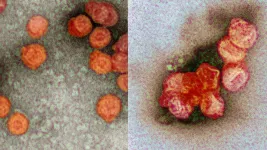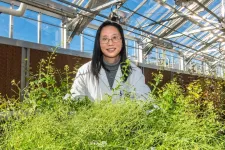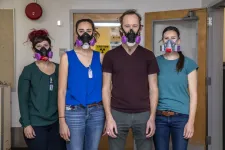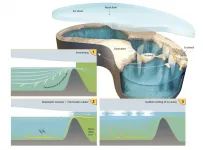Standard water treatment eliminates enveloped viruses -- like the coronavirus
Texas A&M researchers have shown that water treatment has the potential to remove nearly all viruses that have an "outer fortress" from drinking water.
2021-02-03
(Press-News.org) Among the many avenues that viruses can use to infect humans, drinking water may pose only a tiny risk for spreading certain viruses like the novel coronavirus. However, in cases where there is unauthorized wastewater disposal or other events of inadvertent mixing of wastewater with water sources, the possibility of transmission through drinking water remains unknown.
Using a surrogate of the coronavirus that only infects bacteria, researchers at Texas A&M University have now presented strong evidence that existing water purification plants can easily reduce vast quantities of the virus thereby protecting our household water from such contagions. In particular, the researchers showed that the water purification step called coagulation could alone get rid of 99.999% of the virus, markedly decontaminating water for consumption.
"We did not want to wait till drinking water became a potential cause for concern for coronavirus transmission," said Shankar Chellam, professor in the Zachry Department of Civil and Environmental Engineering. "This study shows that decontamination technologies that are already in place in water treatment facilities can remove or inactivate the coronavirus and other viruses that are structurally similar."
Details of their study were published in the American Chemical Society journal Environmental Science and Technology.
Viruses can be categorized between two structural types: those that have an outer fortress, called an envelope, and those that do not. This envelope, consisting of a lipid bilayer and attached proteins, has multiple functions, including aiding the virus in entering host cells. Several infamous viruses have a protective envelope, including coronaviruses and the Ebola virus.
Studies have found both enveloped and nonenveloped viruses in wastewater. However, most research has solely focused on the survival of nonenveloped viruses after wastewater and water treatment.
"It is well known that wastewater mixes with drinking water supplies. In fact, in many countries, including the United States, wastewater is purified and used as drinking water," Chellam said. "If enveloped viruses persist in wastewater, there could be a minuscule chance that these viruses make it into our drinking water supplies. We just don't know for sure."
At treatment facilities, raw water generally undergoes a three-step purification process: coagulation, followed by filtration and disinfection. In the coagulation step, certain metallic salts are added to initiate particles suspended in water to join together into millimeter-sized clumps. These clumps then settle down as sediment and are easily separated from the water. Chellam and his collaborators tested to see if enveloped viruses also assembled into bundles during coagulation.
For their experiments, they added a surrogate of the coronavirus that specifically infects bacteria to clean water. Next, they separately tested the action of a coagulant commonly used in water treatment plants. After coagulation, they studied small samples of the virus-infused water under an electron microscope and found that the virus strain assembled on the coagulants, forming clusters. They then checked the presence of infectious viruses in the water after removing the clumps and they found there was a 100,000 reduction.
"The U.S. Environmental Protection Agency mandates 99.99% of the viruses must be removed or inactivated from drinking water, and we found that even without filtration and chlorination, we were getting rid of 99.999% of the viruses," Chellam said.
The researchers noted that although they used the coronavirus surrogate for their study, the results are readily generalizable to other viruses that have similar surface characteristics, notably a lipid bilayer envelope and similar spike proteins. However, Chellam said that in the real world, wastewater contains a whole slew of viruses, unlike their experiments that included just a single strain of virus. In their next set of experiments, they plan to investigate if coagulation is still as effective at decontamination in these scenarios.
"Our work suggests that surface water treatment plants might be already well equipped to meet virus regulations for drinking water," Chellam said. "And coagulation is just the first step in the water purification pipeline. This is very encouraging since additional purification steps will only attenuate enveloped viruses further, alleviating associated health risks even more."
INFORMATION:
Other Texas A&M contributors to this research include doctoral student Kyungho Kim and Anindito Sen. This research is funded by the National Science Foundation.
[Attachments] See images for this press release:

ELSE PRESS RELEASES FROM THIS DATE:
2021-02-03
The economic value of insect pollinators was $34 billion in the U.S. in 2012, much higher than previously thought, according to researchers at the University of Pittsburgh and Penn State University. The team also found that areas that are economically most reliant on insect pollinators are the same areas where pollinator habitat and forage quality are poor.
"Pollinators like bees play an extremely important role in agriculture," explained senior author Vikas Khanna, Wellington C. Carl Faculty Fellow and associate professor of civil and environmental engineering at Pitt's Swanson School of Engineering. "The insects that pollinate farmers' crops underpin our ecosystem biodiversity and function, ...
2021-02-03
BOSTON - Although abnormal blood clotting has been identified as one of the primary causes of death from COVID-19, early treatment in an intensive care unit (ICU) with therapeutic anticoagulation (anti-clotting) for adults who are critically ill with COVID-19 does not appear to improve chances of survival, and could do more harm than good by increasing the risk for major bleeding, a multicenter research group cautions.
"In patients critically ill with COVID-19, therapeutic dose anticoagulation started early in the ICU stay was not associated with improved survival,"says Hanny Al-Samkari, MD, an investigator in the Division of Hematology/Oncology at Massachusetts General Hospital (MGH) and lead author ...
2021-02-03
Studies examining the effectiveness of treatments for COVID-19 often do not include the very populations hardest hit by the disease, according to a new review by University of Chicago Medicine researchers.
The findings, based on an analysis of all US COVID-19 treatment trials registered on ClinicalTrials.gov, were published Jan. 27 in the Journal of General Internal Medicine.
"This study highlights the blind spot in how clinical trials are done in the United States," said senior author Neda Laiteerapong, MD, MS, a general internist and associate director of the Center for Chronic Disease Research and Policy at the University of Chicago. "Researchers, hospitals and pharmaceutical ...
2021-02-03
UPTON, NY - Hundreds of naturally occurring specialty fatty acids (building blocks of oils) have potential for use as raw materials for making lubricants, plastics, pharmaceuticals, and more--if they could be produced at large scale by crop plants. But attempts to put genes for making these specialty building blocks into crops have had the opposite effect: Seeds from plants with genes added to make specialty fatty acids accumulated dramatically less oil. No one knew why.
Now two teams of biochemists working on separate aspects of oil synthesis at the U.S. Department of Energy's Brookhaven National Laboratory have converged to discover the mechanism behind the oil-production slowdown. As described in the journal Plant Physiology, they crossbred model plants and conducted detailed ...
2021-02-03
TAMPA, Fla. -- The prognosis of ovarian cancer is poor, with an estimated five-year survival of only 40% for advanced disease, the stage at which most ovarian carcinomas are diagnosed. These poor outcomes are partly due to the lack of effective therapies for advanced disease and recurrence. Immunotherapies hold promise for many types of cancer; however, studies have shown that patients with ovarian cancer do not have strong responses to existing drugs. In a new article published in Nature, Moffitt Cancer Center researchers demonstrate why some ...
2021-02-03
There is an impassioned debate taking place in medicine on whether race-based considerations should be a factor in research, diagnoses, or treatments. Those on one side assert that race should be ignored entirely because it is a societal construct with no biological basis, and accordingly many hospitals are abandoning long-established "race corrections" in medical algorithms and diagnostics. Others, like Meghan McGarry, MD, MS, assistant professor of pediatrics at UC San Francisco, say that we can't completely ignore race, precisely because science is rarely free of societal influence - the structural inequality ...
2021-02-03
Since element 99 - einsteinium - was discovered in 1952 at the Department of Energy's Lawrence Berkeley National Laboratory (Berkeley Lab) from the debris of the first hydrogen bomb, scientists have performed very few experiments with it because it is so hard to create and is exceptionally radioactive. A team of Berkeley Lab chemists has overcome these obstacles to report the first study characterizing some of its properties, opening the door to a better understanding of the remaining transuranic elements of the actinide series.
Published in the journal Nature, the study, "Structural and Spectroscopic Characterization of an Einsteinium Complex," was co-led by Berkeley Lab scientist Rebecca Abergel and Los ...
2021-02-03
The Arctic Ocean was covered by up to 900 m thick shelf ice and was filled entirely with freshwater at least twice in the last 150,000 years. This surprising finding, reported in the latest issue of the journal Nature, is the result of long-term research by scientists from the Alfred Wegener Institute and the MARUM. With a detailed analysis of the composition of marine deposits, the scientists could demonstrate that the Arctic Ocean as well as the Nordic Seas did not contain sea-salt in at least two glacial periods. Instead, these oceans were filled with large amounts of freshwater under a thick ice shield. This water could then be released into the North Atlantic in very short periods of time. Such sudden freshwater inputs could explain rapid climate oscillations for which no satisfying ...
2021-02-03
What The Study Did: Data from the Centers for Disease Control and Prevention were used to look at changes in emergency department visits for mental health, suicide attempts, drug and opioid overdoses and outcomes of violence before and during the COVID-19 pandemic.
Authors: Kristin M. Holland, Ph.D., M.P.H., of the Centers for Disease Control and Prevention in Atlanta, is the corresponding author.
To access the embargoed study: Visit our For The Media website at this link https://media.jamanetwork.com/
(10.1001/jamapsychiatry.2020.4402)
Editor's Note: Please see the article for additional information, ...
2021-02-03
What The Study Did: COVID-19 outcomes including hospitalization and in-hospital death were compared between people living with or without diagnosed HIV in New York State.
Authors: Eli S. Rosenberg, Ph.D., of the State University of New York in Rensselaer, is the corresponding author.
To access the embargoed study: Visit our For The Media website at this link https://media.jamanetwork.com/
(doi:10.1001/jamanetworkopen.2020.37069)
Editor's Note: The article includes conflict of interest and funding/support disclosures. Please see the article for additional information, including other authors, author contributions and ...
LAST 30 PRESS RELEASES:
[Press-News.org] Standard water treatment eliminates enveloped viruses -- like the coronavirus
Texas A&M researchers have shown that water treatment has the potential to remove nearly all viruses that have an "outer fortress" from drinking water.




